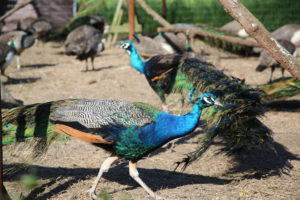Animal behaviorist looks through the eyes of peafowl
Study finds beauty in the eye of the beholder…and rivalry
Writer: Steve Byrns, 325-653-4576, [email protected]
Contact: Dr. Jessica Yorzinski, 979-845-5777, [email protected]
COLLEGE STATION – Flock, muster ostentation, cluster, lek, pulchritude, pride or bawl, no matter what a group of peacocks is called, Texas A&M University at College Station is now home to 40 of them, thanks to a Texas A&M AgriLife Research scientist.
Dr. Jessica Yorzinski with the university’s wildlife and fisheries sciences department, said her research flock arrived in College Station last fall and are settled in and happily enjoying Texas weather.
Yorzinski uses the birds to conduct a variety of behavioral studies. She trapped the original set from feral populations in Florida and California about eight years ago.

“I chose peafowl as study subjects because I was looking for a species in which males exhibited elaborate ornaments that females could use to assess their mates and other males could use to assess their rivals,” she said. “That was one reason, and the other reason was they are relatively large birds, so they are able to easily sport the equipment I use in my studies.”
One such study, Selective Attention in Peacocks During Assessment of Rival Males, was published in the Journal of Experimental Biology on March 15. The work and list of authors is available http://jeb.biologists.org/content/current. In the study Yorzinski looks through the eyes of the birds to actually see what the animals are paying attention to, in this particular case, how males size up their competition.
“It is important to understand how males are evaluating each other during the breeding season because their ability to compete with other males can impact their chances of copulating with females,” she said.
She found the males look at the lower regions of the other male’s display, mostly looking at the lower eyespot areas as well as the body of the rival. They also pay more attention to their rivals when said rivals are moving around or shaking their wings, but not when they are shaking their long train of decorative tail feathers. That particular movement apparently only interests the “girls.”
Yorzinski said peacocks set up territories, which they defend against rivals, and peahens visit these territories to check out potential mates.

“What we learned is that the males are evaluating similar traits when inspecting their rivals as females are evaluating when choosing their mating partners, but they are doing this, of course, for very different reasons.
“Competition among males can be costly in terms of energy expended and injuries, so males tend to spend a good amount of time, almost a third, sizing up the competition,” she said. “However, unless they are actively courting a peahen, the girls only get a glance from the males about 5 percent of the time.”
So how does one look through the eyes of a peacock? Yorzinski said that’s done through a novel approach called eye-tracking. The birds are equipped with cameras able to monitor their precise gaze behavior. The cameras were left on the birds about an hour as called for in the trial, so they didn’t have to wear the equipment continuously.
“Peafowl only mate a few months out of the year,” she said. “The males generally start displaying in early spring and continue until mid summer when they drop all their feathers and start growing a new set for the next season.
Since in the wild, being eaten by a predator is always a risk when one is distracted by too many stimuli or by a rival or prospective mate, the birds, both male and female, have likely evolved the ability to selectively shift their gaze among competing interests.
“It would be fascinating to extend this work to other species, including our own, to determine how animals are checking out their competition,” she said.
In the meantime, Yorzinski said one of the next projects she’s working on is using a system that tracks both of the birds’ eyes at the same time.
“So far, we’ve had to put a patch over one of their eyes due to technological limitations, so the next step is to look at all the visual information that the birds use and extend this current work into other contexts like navigation and foraging.”
Contact Yorzinski at 979-845-5777, [email protected] or visit her website at http://www.jessicayorzinski.com/.


